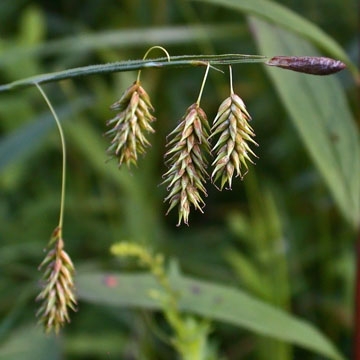

Carex castanea - (image 1 of 3)
Taxonomy
Family: Cyperaceae
Section Hymenochlaenae
Habitat
Swamps, wet meadows, edges of mixed or coniferous woods, often in calcareous soils.
Associates
Distribution
Newfoundland to western Ontario, south to CT, MI, and MN.
Morphology
Tufted perennial, 30-90 cm, purplish at the base, the stems surpassing the leaves; main leaves 3-6 mm wide, soft hairy; terminal spike staminate, erect and long-pedunculate; lateral spikes usually 3, pistillate, on slender, spreading or drooping peduncles, short-cylindric, closely 10-40-flowered in several rows; lower bracts setaceous, villous-ciliate, with very short sheath, the upper usually bladeless; pistillate scales ovate or ovate-oblong, chestnut brown, about equaling the body of the perigynium, acute to acuminate or minutely cuspidate; perigynia lanceolate, 3.5-5.8 mm, glabrous, obscurely trigonous, strongly 2-ribbed and finely several-nerved, tapering to a slender bidentate beak half as long as the body; achene concavely trigonous.
Notes
Fruiting June to September
Wetland indicator: FACW
Can hybridize with C. arctata. The name refers to the color of the pistillate scales.
References
Gleason, Henry A. and A. Cronquist. 1991. Manual of Vascular Plants of
Northeastern United States and Adjacent Canada. Second Ed.
The New York Botanical Garden. Bronx, NY
|
© Michael Hough 2018 |